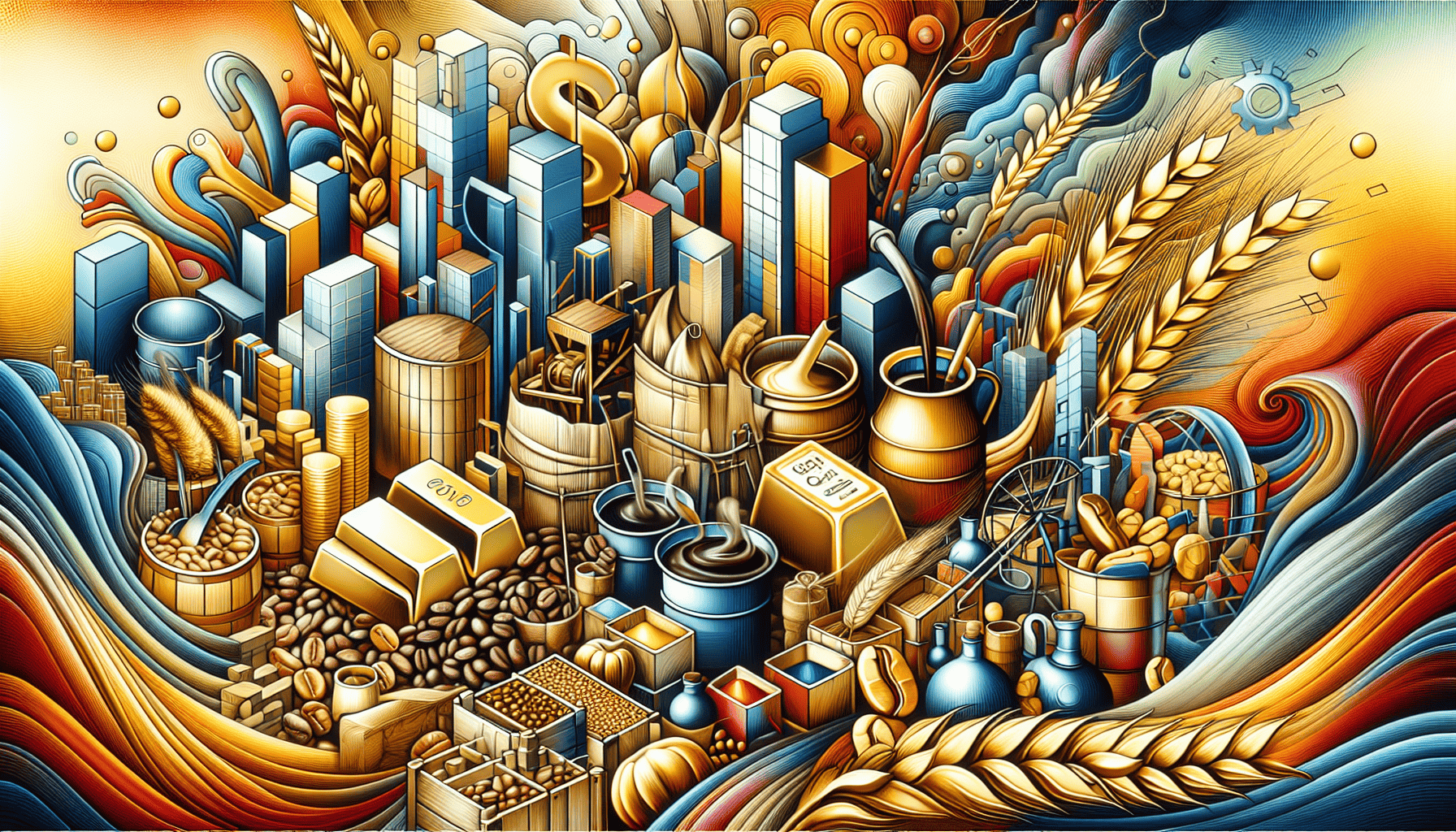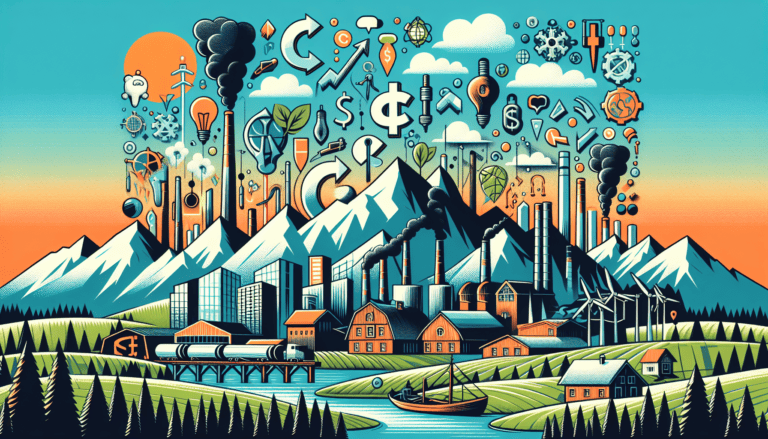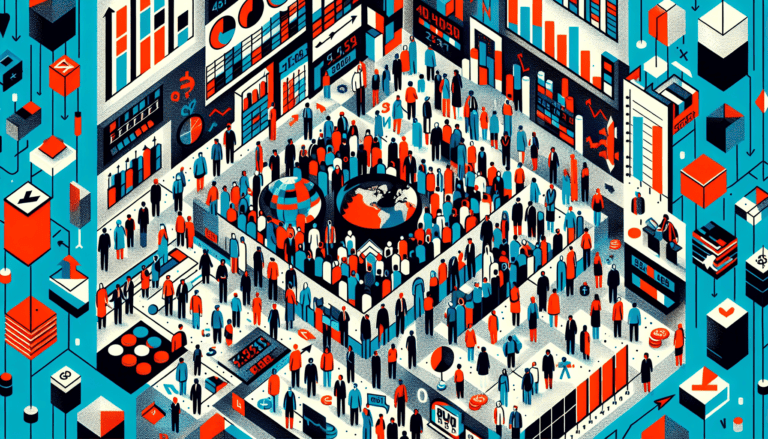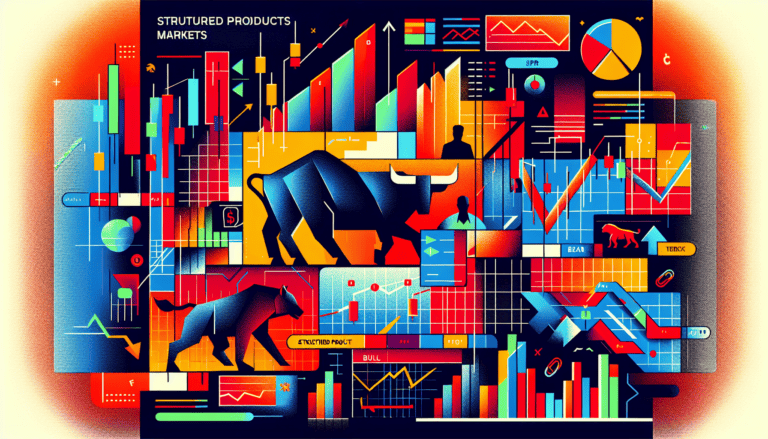Mastering the Art: Beginners Essentials of Commodity Markets and Trading

Understanding Financial Markets
The foundation of investing begins with a comprehensive understanding of financial markets, where a variety of assets are traded. These markets are crucial for the efficient allocation of capital and resources in an economy. For beginners, grasping the underlying structure of these markets is the first step towards successful investment, especially in areas such as commodity markets and trading.
Types of Financial Markets
Financial markets can be broadly categorized based on the types of assets traded and their characteristics. Here’s a brief overview:
- Equity Markets: Often referred to as stock markets, they deal with the trading of company shares. New shares are sold in the primary market, while existing shares are traded in the secondary market. Equity markets explained.
- Bond Markets: These markets facilitate the trading of debt instruments where investors lend money to issuers (corporate or government) in return for periodic interest payments. Bond markets decoded.
- Derivatives Markets: Derivatives are financial contracts whose value is derived from underlying assets like stocks, bonds, commodities, etc. Derivatives markets overview.
- Commodity Markets: These include physical goods like gold, oil, and agricultural products, and are a major focus for those interested in commodity markets and trading. Commodities as an asset class.
- Forex Markets: The largest in terms of daily trading volume, these markets deal with the exchange of currencies. Forex markets: currency trading simplified.
- Cryptocurrency Markets: A newer market where digital or virtual currencies, like Bitcoin, are traded. Cryptocurrency markets: the digital frontier.
The following table summarizes the key financial markets and their functions:
| Market Type | Description |
|---|---|
| Equity | Trading of company stocks |
| Bond | Trading of debt securities |
| Derivatives | Contracts derived from other asset classes |
| Commodity | Trading of physical goods |
| Forex | Exchange of currencies |
| Cryptocurrency | Trading of digital currencies |
Role of Financial Markets
Financial markets serve several key functions in an economy. They:
- Enable Capital Formation: By connecting savers with businesses and governments that need capital, financial markets facilitate the flow of money and resources.
- Provide Liquidity: They allow investors to buy and sell assets with ease, which is crucial for investment flexibility and confidence.
- Price Discovery: Through the interaction of buyers and sellers, markets help in determining the fair price of traded assets.
- Risk Management: Instruments like options and futures enable traders to hedge against risks associated with price volatility.
- Economic Indicators: The performance of financial markets often reflects the health of an economy, providing insights to policymakers and investors alike.
By understanding the types and roles of financial markets, individuals new to the investment world can better navigate the complexities of trading and investment, especially when venturing into specialized areas like commodity markets and trading. Whether interested in emerging markets or insurance markets, the principles of financial markets provide a solid foundation for further exploration and successful investment.
Introduction to Commodity Markets
Commodity markets and trading play a pivotal role within the broader spectrum of financial markets. For beginner investors eager to develop a comprehensive understanding of investment opportunities, grasping the essentials of commodity markets is a key stepping stone.
What Are Commodities?
Commodities are fundamental goods used in commerce that are interchangeable with other goods of the same type. Traditionally, they are the building blocks for more complex products and services. These raw materials are often the foundation of global economies and are traded on dedicated markets—a process that has evolved significantly over the years. Since the 1990s, commodities have been recognized as an asset class, leading to the creation of commodity futures indexes and a variety of investment vehicles, such as mutual funds and exchange-traded funds or notes, that offer exposure to single commodities, sectors, or a broad range of commodities (PIMCO).
Key Types of Commodities
The realm of commodities is typically segmented into two broad categories: Hard commodities, which include mined or extracted resources like metals and energy products, and soft commodities, which consist of agricultural products or goods that are grown rather than mined.
| Category | Examples |
|---|---|
| Hard Commodities | Energy (Oil, Natural Gas), Metals (Gold, Silver, Copper) |
| Soft Commodities | Agricultural (Wheat, Corn, Soybeans), Livestock (Cattle, Pork Bellies) |
These commodities are crucial for the production of consumer products and significantly influence the economies of commodity-exporting nations. For instance, commodities account for a significant portion of Australia’s exports, making their prices a determinant of the terms of trade, the value of the Australian dollar, and the overall national income, which in turn affects aggregate demand.
By understanding the different types of commodities and their impact on the global market, investors can make informed decisions about including them in their investment portfolios. To delve deeper into the various financial markets, readers can explore equity markets explained, bond markets decoded, derivatives markets overview, and other related topics such as forex markets: currency trading simplified or cryptocurrency markets: the digital frontier. Each market offers unique opportunities and carries specific risks, thereby necessitating a broad and nuanced perspective for beginner investors.
Commodity Markets and Trading
The world of finance is diverse, and among its many facets, the commodity markets play a pivotal role. For individuals new to investments, understanding commodity markets and trading is essential to grasp the broader economic picture and make informed decisions.
Trading Platforms and Methods
Commodity trading involves the buying and selling of physical goods such as gold, oil, natural gas, and agricultural products. It can be conducted through various platforms, including:
- Commodity Exchanges: Organized marketplaces where commodities are traded, typically through standardized contracts.
- Over-the-Counter (OTC) Markets: Decentralized markets where trading is done directly between two parties, without the oversight of an exchange.
- Online Trading Platforms: Digital platforms that allow traders to buy and sell commodities electronically.
There are several methods for trading commodities, each catering to different investment strategies and risk appetites:
- Futures Contracts: Agreements to buy or sell a commodity at a predetermined price at a specific time in the future.
- Options Contracts: Contracts that give the buyer the right, but not the obligation, to buy or sell a commodity at a set price within a specified period.
- Exchange-Traded Funds (ETFs): Investment funds that track the price of commodities and are traded on stock exchanges.
- Over-The-Counter (OTC) Derivatives: Customized contracts that are negotiated directly between two parties.
Each trading method comes with its own set of risks and benefits, and it’s crucial for beginners to understand these before diving into commodity trading. More information on trading methods can be found in our articles on derivatives markets overview and exchange-traded funds (etfs) and mutual funds markets.
Participants in Commodity Trading
The participants in commodity trading are as diverse as the methods they employ. They include:
- Producers: Entities that create the commodities, such as farmers and oil companies, often looking to sell their produce at the best possible prices.
- Consumers: Companies that require commodities as inputs for their production, such as manufacturers and energy companies, aiming to buy at favorable prices.
- Speculators: Traders who buy and sell commodities purely for financial gain, capitalizing on price movements.
- Arbitrageurs: Individuals or firms that seek to profit from price discrepancies between different markets or products.
Each participant plays a significant role in the commodity markets, contributing to the liquidity and price discovery process. Their activities help to ensure that the commodity markets function efficiently, allowing for the global trade of essential goods.
| Participant | Role | Motivation |
|---|---|---|
| Producers | Create and sell commodities | Maximize sales price |
| Consumers | Buy commodities for production | Minimize purchase price |
| Speculators | Trade for profit | Capitalize on price movements |
| Arbitrageurs | Exploit price discrepancies | Profit from market inefficiencies |
As commodity markets are global and trade around the clock, investors have the opportunity to access various markets and take advantage of price fluctuations. This round-the-clock trading environment makes commodities an attractive asset class for many investors looking to diversify their portfolios or hedge against inflation and other economic variables. For an in-depth look at the various financial markets, interested readers can explore articles like equity markets explained and bond markets decoded.
Understanding the roles and motivations of the different market participants can greatly benefit beginner investors as they navigate the complexities of commodity markets and trading.
Price Dynamics in Commodity Trading
Factors Influencing Commodity Prices
The prices of commodities are subject to a variety of influencing factors. Key among these are supply and demand dynamics, which can be affected by geopolitical events, weather patterns, government policies, and global economic trends (Investopedia). For example, an unexpected frost can devastate an entire crop, significantly reducing supply and causing prices to surge. Similarly, political instability in a region rich in natural resources can restrict supply and lead to price volatility.
To illustrate how these factors can impact commodity prices, here’s a simplified table:
| Factor | Potential Impact on Commodity Prices |
|---|---|
| Supply Disruption | Increase |
| Demand Surge | Increase |
| Technological Advancements | Decrease (due to increased production efficiency) |
| Economic Downturn | Decrease (due to lower demand) |
Understanding these dynamics is crucial for anyone involved in commodity markets and trading, as they can significantly affect the profitability of trades.
Managing Price Risk
Managing price risk is a fundamental aspect of commodity trading. Price risk refers to the uncertainty and potential volatility in the prices of commodities which can significantly impact businesses and investors. One common strategy to mitigate this risk is hedging, which involves using derivative contracts like futures or options. By locking in prices for future delivery or protecting against adverse price movements, traders and businesses can insulate themselves from some of the unpredictability inherent in these markets.
For instance, an agricultural producer might use futures contracts to lock in the price of their crop ahead of the harvest. If prices fall by the time the crop is ready for market, the producer is protected against the decline. Conversely, if prices rise, they won’t benefit from the increase but are shielded from losses.
Here’s a quick look at some hedging instruments:
| Hedging Instrument | Description |
|---|---|
| Futures Contracts | Agreements to buy or sell a commodity at a predetermined price on a specified future date. |
| Options Contracts | Contracts that give the buyer the right, but not the obligation, to buy or sell a commodity at a set price before a certain date. |
Hedging can be a complex process, and it’s recommended that those new to commodity trading educate themselves thoroughly or seek professional advice before employing such strategies. Additional information about managing price risk can be found in articles on derivatives markets overview and OTC markets and counterparty risks.
Commodity trading offers both challenges and opportunities. By understanding the factors that influence prices and employing strategies to manage risk, participants can make more informed decisions and work to secure their investments against the unpredictable nature of the markets.
Trading Strategies in Commodities
For beginner investors venturing into commodity markets and trading, understanding the range of trading strategies is paramount to navigating this sector successfully. There are two primary approaches to analyzing and making decisions in the commodities market: fundamental analysis and technical analysis. Moreover, several strategic methods are employed by traders to optimize their market positions.
Fundamental vs. Technical Analysis
Fundamental analysis in the realm of commodities involves examining external factors that can influence prices, such as supply and demand dynamics, weather conditions, geopolitical events, and government policies. This form of analysis is crucial because these factors can have substantial impacts on commodity prices (Forex.com).
Alternatively, technical analysis serves traders by identifying patterns and trends within price data. This includes pinpointing support and resistance levels and other chart patterns, which guide traders in making informed decisions. Technical analysis is predicated on the idea that price movements are not random and that historical price movements can indicate future price directions (Forex.com).
Popular Commodity Trading Strategies
A variety of strategies are prevalent among commodity traders, each with its own methodology and focus:
Trend Following
Trend following is a strategy that hinges on the analysis of historical price data to discern trends. Traders implementing this strategy will enter trades that align with the detected trend, capitalizing on the tendency of trends to persist over time. The goal is to ride the trend until evidence suggests a reversal is imminent (The Balance).
Discretionary Trading
Discretionary trading is a more subjective approach, where traders rely on their judgment and intuition to make trades. This strategy isn’t bound strictly by technical indicators or algorithms; instead, it enables traders to leverage short-term market opportunities and adapt swiftly to changes in market conditions.
Spread Trading
Common in the commodities markets, spread trading involves the simultaneous purchase and sale of related contracts for the same commodity but with different delivery dates. Traders utilize this strategy to capitalize on price discrepancies between contracts, which can also serve as a hedge against price volatility, moderating the impact on their positions (The Balance).
| Strategy | Description | Focus |
|---|---|---|
| Trend Following | Identify and trade with the direction of market trends. | Historical price trends |
| Discretionary Trading | Use personal judgment to make trading decisions. | Short-term market opportunities |
| Spread Trading | Trade price differences between related contracts. | Price discrepancies & hedging |
As investors familiarize themselves with commodity markets and trading, it’s vital to understand that no single strategy guarantees success. Instead, an individual’s risk tolerance, investment goals, and market knowledge will shape their approach. Further education on various market types, such as equity markets, bond markets, and derivatives markets, can also provide a more comprehensive financial market foundation.
Global Impact of Commodity Markets
Commodity markets and trading have significant implications for both global and national economies. The prices of commodities can influence economic growth, inflation, and even the balance of trade. Understanding these impacts is essential for beginner investors who are venturing into the world of commodities.
Commodity Prices and the Economy
Commodity prices can act as a barometer for the health of the global economy. For example, a rise in energy prices often signals increased industrial activity and economic growth, while a decline might indicate a slowing economy. Additionally, countries that are major exporters of commodities, such as Australia, can see their currency’s value fluctuate in line with commodity prices. The Reserve Bank of Australia (RBA) outlines that commodities account for two-thirds of the value of Australia’s exports, affecting the Australian dollar, national income, and aggregate demand (RBA).
| Commodity | Impact on Economy |
|---|---|
| Energy (Oil, Gas) | Inflation, Industrial Growth |
| Metals (Iron, Copper) | Construction, Manufacturing |
| Agricultural (Wheat, Corn) | Food Prices, Consumer Spending |
Emerging market and developing economies that rely heavily on commodity exports may face inflationary pressures and fiscal vulnerabilities when prices rise, as noted by a recent IMF report (source).
Case Studies: Commodity Price Fluctuations
Analyzing case studies of commodity price fluctuations can provide insights into the factors influencing these changes and their subsequent impact on economies.
-
Crude Oil Prices: The price of Brent crude oil reached $100 per barrel in September 2023, the highest level since October 2018. This surge in energy prices was driven by strong demand, supply disruptions, and increasing inflation expectations (source).
-
Agricultural Commodities: In the first half of 2023, food prices increased by 39.1%, driven by adverse weather conditions, supply chain disruptions, and strong demand. These factors culminated in sharp rises in agricultural commodity prices, affecting global food security and consumer prices.
-
Supply Disruptions: The spike in coking coal prices due to supply disruptions caused by Tropical Cyclone Debbie in 2017 is an example of how natural disasters can dramatically affect commodity prices. The RBA’s dynamic factor model helps quantify the contributions of global, block, and commodity-specific factors to these price movements (RBA).
By studying these case studies, investors can better understand how commodity markets respond to various global events and economic indicators. For those interested in exploring other financial markets, internal links to resources such as equity markets explained, bond markets decoded, and forex markets: currency trading simplified can provide a comprehensive overview. For more specialized markets, one might consider carbon markets and environmental trading or private equity and venture capital markets.
The global impact of commodity markets underscores the importance of commodities in the broader financial ecosystem. Beginner investors should recognize the interconnected nature of these markets and how they can affect investment outcomes across various asset classes.





